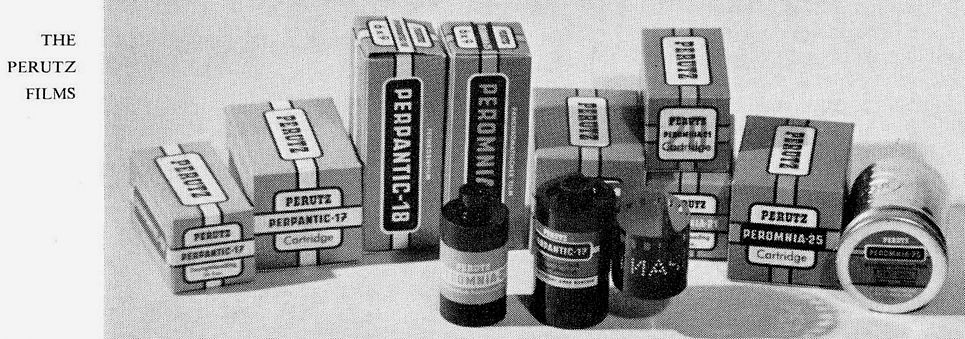| Early Perutz colour and black & white materials - researched by Michael Talbert |
|
|
|
|
Index to this web
page: Information on post-1964 Agfa-Gevaert
materials is available on the Agfa
web page; Gevaert information is here |
|
|
|
||
|
Perutz films in the early 1930s
were Perutz Pergrano, Perutz Perpantic, Perutz Peromnia and Perutz
Rectipan. Perutz films in 1939 were: In the BJPA for 1952, in the
'New Goods' section, there is a test on Perutz 'Persenso' orthochromatic
roll film. In the 1930s this film was known as 'Perutz Neo Persenso'. The film was numbered on the rebate 1 to 12 for 2¼ inches square negatives and also 1 to 16 for the half 2¼ by 3¼ inches negative size. It cost 3 shillings and 3 pence
plus 1 shilling and 6 pence purchase tax i.e. 4s and 9 pence
(4s.9d = 24p) per 120 roll. The film was distributed (maybe imported) by 'Milbo Trading Ltd', Ascot House, 52/53 Dean Street, London W1. Perutz were manufacturing many black and white materials in the 1950s. The BJPA for 1954 lists as many as seven different glass plates, including one called 'Silver Eosin'; also a 35mm black and white reversal film rated at 15 DIN, about 25 ASA. |
||
| An article extracted
from Miniature Camera Magazine (MCM) Test Report dated
January 1959. Perutz Films Again (the picture below is taken from the same article) |
||
 |
||
|
Verbatim from January 1959 article : The firm of Otto Perutz of Munich is well known on the Continent as manufacturers of first-class sheet, roll and miniature films and was one of the first to make and pack special films for the Leica. MCM. has a long experience of Perutz films, for they were first reviewed in our January 1937 issue, just 22 years ago! The British agency for Perutz film has now been acquired by Hanimex (U.K.) Limited, who have sent us examples of Peromnia 25 both 120 and 35 mm. cassettes and reloads; Peromnia 21 also in both 120 and 35 mm., Perpantic 18 in 120 size only, Perpantic 17 in 35 mm. only. The numbers printed on the cartons represent the new German way of indicating DIN speeds, the stroke and the 10 degree marking now being abandoned. Thus Peromnia 25 is rated at 25 DIN or 250 ASA; Peromnia 21 at 21 DIN and 100 ASA; Perpantic 18 at 18 DIN or 50 ASA; Perpantic 17 at 17 DIN and 40 ASA; and there is also a Pergrano 14 rated at 14 DIN and 20 ASA which is not included in those sent to us for review but which we have used on previous occasions with success. It is characteristic of all these films that unlike the usual 35 mm. films which depend for their antihalation properties on the grey base, the Perutz films now have an opaque black backing which is bleached in the developer and by the time the film has gone through the fixing bath has entirely disappeared. The improvement in anti-halation properties is quite noticeable in subjects with strong light sources included in them. All of the films have been improved in the last few years. The Peromnia 25 is extremely fast and is intended for artificial light work, having a considerably increased red sensitivity for this reason. This is indicated by the fact that with a bright red filter in daylight the factor is only 4 whereas with the Perpantic 17 the factor is 5. Peromnia 21 is intended as a general purpose film of a fast type while Perpantic 18 in roll film form and Perpantic 17 in 35 mm. emulsion are medium contrast emulsion films fully adequate in speed for most purposes. The Pergrano 14 is an ultra fine grain very thin emulsion film for those who require the maximum resolution and highest acutance. It is worth while pointing out that the Perutz 35 mm cassettes are of very high quality, being made of plastic and easily refillable. Our tests of the whole range of films showed excellent gradation and quality throughout the exposure range with the developers recommended and it is interesting to note that development times are given for D.76 and Microdol as well as for Perutz's own developers. Prices for Peromnia roll film (120 or 620) is 3s.1d (15.5p); 7s.0d (35p) for 36 exposure cassette; 5s.3d (26p) for 20 exposure cassettes; 5s.3d (26p) and 3s.8d (18p) respectively for 36 and 20 exposure daylight reloads. The prices are the same for the rest of the films except that Peromnia 21 and Perpantic 18 are 2s.l0d (14p) each for the 120 and 620 spools. It should be noticed that we have deliberately referred to "daylight reloads" as the normal reloads for 35 mm. films have to be inserted in the darkroom. These daylight reloads have their own centre spool and an opaque paper leader. To reload a cartridge it is only necessary to remove the cap, take out the used spool, and drop in the daylight reload, removing the paper leader to get at the tongue of the film. This daylight loading is naturally a great convenience for one saves 1s.9d (9p) by using the original cassette. This refill fits Leica, Contax and Shirley-Wellard cassettes. |
||
|
|
|
|
|





